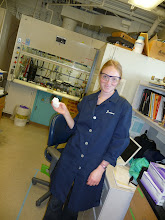Did you ever wonder why grinding two solids together sometimes produces a liquid?
Depending on the relative amounts of each component in a mixture, the melting point varies. The lowest temperature (as a function of mixture composition) at which the mixture melts is referred to as the "eutectic temperature" from the Greek word for "easily melted." The temperature and composition associated with the eutectic reaction are collectively called the "eutectic point."
Eutectic points are exploited in various ways. You are probably familiar with many of them already! For example, during the winter people often sprinkle salt (sodium chloride) over the roads in order to decrease the melting/freezing point of ice. So if the temperature outside is 0°C, the water present on the road will not freeze. The eutectic temperature of water and salt is -21.1°C (for 76.7% water and 23.3% salt), so it would have to be much colder outside for a significant amount of ice to develop on the road. Various other solids can be mixed with water to decrease its freezing point as well!
Depending on the relative amounts of each component in a mixture, the melting point varies. The lowest temperature (as a function of mixture composition) at which the mixture melts is referred to as the "eutectic temperature" from the Greek word for "easily melted." The temperature and composition associated with the eutectic reaction are collectively called the "eutectic point."
Eutectic points are exploited in various ways. You are probably familiar with many of them already! For example, during the winter people often sprinkle salt (sodium chloride) over the roads in order to decrease the melting/freezing point of ice. So if the temperature outside is 0°C, the water present on the road will not freeze. The eutectic temperature of water and salt is -21.1°C (for 76.7% water and 23.3% salt), so it would have to be much colder outside for a significant amount of ice to develop on the road. Various other solids can be mixed with water to decrease its freezing point as well!
But why does mixing two solids together always result in a decreased melting/freezing point rather than an increased melting/freezing point?

It is believed that a complex is formed between hexafluorobenzene and mesitylene. The complex is thought to be a "Lewis base - Lewis acid" type complex, in which one component (electron-rich mesitylene) supplies charge to the other component (electron-deficient hexafluorobenzene). Hexafluorobenzene is so electron-deficient due to the strong electron-withdrawing nature of the fluorine substituent, which is the most electronegative element.
[1] Patrick, C. R.; Prosser, G. S. Nature, 1960, 187, 1021.





No comments:
Post a Comment